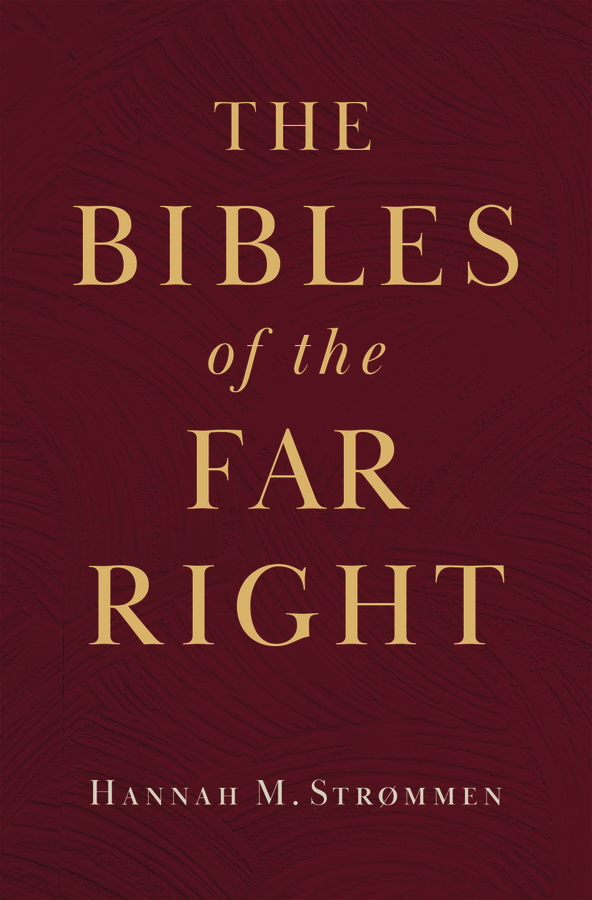 Sometimes a book is exciting because it prompts you to think in new ways. At other times it seems important to understanding a particular historical moment. Rarely does a book do both. Hannah Strømmen’s The Bibles of the Far Right is an exception. In the circumstances in which I write, one could re-title this provocative book “Bibles of the increasingly-not-so-far-and-shockingly-entering-the-mainstream right.”
Sometimes a book is exciting because it prompts you to think in new ways. At other times it seems important to understanding a particular historical moment. Rarely does a book do both. Hannah Strømmen’s The Bibles of the Far Right is an exception. In the circumstances in which I write, one could re-title this provocative book “Bibles of the increasingly-not-so-far-and-shockingly-entering-the-mainstream right.”
While ostensibly focused on the multiple and various sources that “stick” to the manifesto of Norwegian mass murderer Anders Breivik, the scope of Strømmen’s study is far more ambitious. Versions of what she describes as the “Civilization Bible” and “War Bible” assemblages are ubiquitous. As I write, they are emerging as federal policy guideposts in the United States, for example.
Strømmen prepares the ground well for a capacious interpretation of her argument. As a scholar of biblical reception, her central gambit is that Bibles belong to all of us, whether we like it or not, are aware of it or not, and acknowledge it or not (227). Drawing on an impressively diverse range of scholarship, including the work of James Bielo, Sara Ahmed, and Gilles Deleuze and Felix Guattari, Strømmen focuses on what she describes as “Bible-use” (163). She seeks to understand how the authority associated with Bibles works in practice (233), and specifically how texts function “beyond the textual,” including how affect is mobilized and circulates in and through biblical assemblages. Bibles in this view are artifacts and archives (287) that can never be fully disentangled from their “non-Biblical components.” She explains:
What I have attempted to do in this book is to map key elements in Bible-use that have become—for a time—stabilised as part of a political narrative in which Christian Europe is battling “Islamisation.” The Civilization Bible assemblage and the War Bible assemblage have both played a role in the political pronouncements and practices of people peddling far-right conspiracies about the decline of Europe and the threat of Islam (295).
Importantly, these assemblages include not only specific biblical texts but also “the other elements that are stuck to these bits of Bible” (222). The notion of assemblages comes from Deleuze and Guattari, for whom assemblages “select elements from the milieus (the surroundings, the context, the mediums in which the assemblages work) and bring them together in a particular way” (Strømmen, 59; citing J. McGregor Wise, “Assemblage,” 78). As Strømmen emphasizes, however, assemblage “is used not only to describe a number of different things brought together…but is a mode of analysis that allows something new to be seen” (68).
What does a focus on biblical assemblages together with the far right allow us to see anew? When it comes to biblical assemblages of the far right, the “War Bible” and “Civilization Bible,” (as well as, though less prominently, the “Colonial [or Cultural] Bible” [198, 201] and the “Slavery Bible”—rich and fascinating elements of the discussion), there is certainly more to them than meets the eye. Rather than dismissing these currents as pathological misreadings or misapplications of an antiquated text that is (or should be) isolated from “normal” society and politics, Strømmen shows that these assemblages draw on, contribute to, and are immersed in a range of powerful cross-cutting narratives, including but certainly not limited to those associated with far-right extremism. Exploring the “citational network” of Anders Breivik’s manifesto allows her to unpack and explore these narratives. That fine-grained work makes up the bulk of the book. It also allows her to foreground “counter-Bibles,” which, as their name suggests, work at cross-purposes to the assemblages that Strømmen tirelessly maps, catalogues, and critiques.
This swirling tempest of Bibles, counter-Bibles, and biblical assemblages came together in the following especially lucid passage describing the varied elements of the Civilization Bible:
This Civilization Bible assemblage is assembled with the institutions and artifacts of high art found across Europe’s galleries and museums, with literary canons and musical giants such as Shakespeare and Bach; it is assembled with the notions of secularity that are seen as shaping European societies; it is assembled with the colonial missions that celebrated Western superiority with an unparalleled confidence. Most of these associations or components are not and do not need to be spelled out when the Civilization Bible is invoked (202).
The Civilization Bible assemblage invoked by Breivik, she explains, “works because it is reterritorializing Bibles that were operative in the past, in the making of modern Europe, particularly in theological developments during the Enlightenment and Europe’s colonial era.” Non-biblical elements are crucial to this assemblage, including for example the clash of civilizations thesis which “makes the Civilization Bible work as an effective part of a far-right worldview in which the othering of Islam is central” (202). And not only the far right.
Strømmen’s mapping of notions of masculinity in these assemblages is especially compelling. Aggrieved entitlement—or what Axios described recently as “masculine maximalism”—are at the heart of the War Bible assemblage (169–74). Strømmen opens the discussion with the (under)statement that “gender issues are highly pertinent in the Breivik case and in the politics of contemporary far-right movements more generally” (169). She offers as evidence Breivik’s manifesto in which he “brings together his antagonism toward feminism and modern approaches to the Bible when he bemoans the way ‘traditional courses on “dead white males” (such as Shakespeare, Milton and Chaucer)’ are being replaced ‘with courses on women’s studies or “The Bible as Literature” (a course designed to denigrate the Bible as cleverly crafted fiction instead of God’s truth)'” (169). Elsewhere in the manifesto he complains about how so-called Cultural Marxists designate ‘“Muslims, Feminist women, homosexuals and some additional minority groups as virtuous and they view ethnic Christian European men as evil’” (170).
Masculinity as a component of the War Bible assemblage is simultaneously biblical and non-biblical. Here Strømmen draws on Jorunn Økland’s comparison of misogyny in the Book of Revelation to Breivik’s hateful views of women in the manifesto, while also relying on Michael Kimmel’s work to explore the extra-biblical “aggrieved entitlement” that is also pervasive in the manifesto. Kimmel explores “’how downward mobility, economic instability, sexual insecurity, and shifts in gender politics combined to contribute to a sense of loss among many American men, leading to a pervasive sense of aggrieved entitlement’”(Kimmel, 18; in Strømmen, 171). Arlie Russel Hochschild has also explored this sense of loss in her more recent work.
Breivik’s misogynistic, Islamophobic, and homophobic statements do not bear repeating, but the War Bible as invoked in his manifesto, as well as the many parallel biblical assemblages circulating in the US and Europe today, resonate broadly with the trope of aggrieved masculinity. In Breivik’s case, as Strømmen convincingly concludes, the War Bible assemblage was “made up of references to David fighting Goliath; it is made in conjunction with Brievik’s dress-up as a policeman on Utøya, with his game-playing of World of Warcraft, with his crusader costume, his paganly named weapons, and his car named after Thor’s wagon. Connecting the Breivik case to Kimmel’s discussion of aggrieved entitlement points toward broader tendencies relating to violence and masculinity, particularly as they function in right-wing ideology and practice” (171, emphasis mine).
We know these men. We know their “ugly freedoms.” Aggrieved entitlement leads to “’sporadic outbursts, clandestine terrorist conspiracies, and paranoid political thinking’” (Kimmel, 18; quoted in Strømmen, 171) in which anger is funneled toward “’a generalized ethnic and racial “other”—who is seen as threatening to transform America from a Christian (read: white) nation into a multicultural polyglot with no center of racial gravity’” (Kimmel, 28, quoted in Strømmen, 172).
Aggrieved entitlement is not only worked into Breivik’s War Bible assemblage, however. It is the political air we breathe in the United States today, coursing through a tsunami of executive orders issued in the first hours and days of the Trump administration, jumping off the pages of Presidential Actions including “Defending Women from Gender Ideology Extremism and Restoring Biological Truth to the Federal Government,” “Ending Illegal Discrimination and Restoring Merit-Based Opportunity,” and “Protecting the United States from Foreign Terrorists and Other National Security and Public Safety Threats.” Aggrieved entitlement has boiled over in the global United States.
Strømmen keeps her cool, however, taking the analysis further by observing that even as the term toxic masculinity may be appealing, to use it would be a mistake. Citing Elizabeth Pearson’s study of the English Defence League, Strømmen insists that “labelling it as ‘toxic’ occludes its continuities with wider patriarchal norms” and subtly downplays the fact that these actors “activate notions of masculinity that are already there in society” (Pearson, 1268; cited in Strømmen, 173). Indeed. Describing aggrieved masculinity as “toxic” serves to stigmatize a few “bad” men while sanitizing and quietly exonerating the rest of the “masculine maximalist” playing field. Strømmen warns that this could “be seen as a problem with the Breivik case, where he becomes an exceptional figure who is dismissed as irrelevant” (173). As this powerful book demonstrates time and again, Breivik’s views are far from exceptional, and anything but irrelevant.
In the subsequent interview, I ask Professor Strømmen to reflect on the conceptual limits of the various biblical assemblages she identifies, the theoretical influences that shaped her thinking, and the role of affect in her account of the Bibles of the far right.

